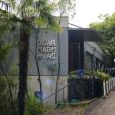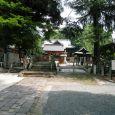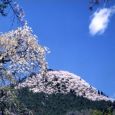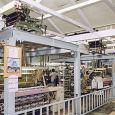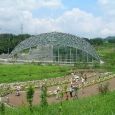Kiryu
Advertisement
By train
Kiryu lies about halfway between Oyama and Takasaki on the JR Ryomo line, about 1 hour by local train from either end. About 30 trains per day pass through in each direction, and the fare runs about ¥1000 each way.
The Tobu Isesaki line express train Ryomo, which requires seat reservations, stops at Tobu Shin-Kiryu station on its run between Asakusa and Akagi. It leaves Asakusa at 40 mins past the hour, costs about ¥2400, and takes about 90 mins in either direction. The short local Tobu Kiryu line stops at Shin-Kiryu on its run between Ota City and Akagi.
The Watarase Keikoku railway starts at JR Kiryu station and intersects the Tobu Kiryu line at Aioi before heading up through the scenic mountains and gorges to the headwaters of the Watarase River valley. There are 18 trains a day each way between Kiryu station and omama in Midori City, but only 11 that cover the full distance to Ashio and Mato, which are now administered by Nikko. The first train leaves Kiryu at 6:39 and the last train leaves Mato at 7:51 pm. The full-distance fare is about ¥1050 each way.
By bus
The Keisei Bus Salvia line runs directly between Narita airport and Kiryu 4 times each way daily for ¥4300 one way. The trip takes about 3 hours, depending on Tokyo traffic. Four buses leave JR Kiryu station South Exit between 4:20 am and noon, and four buses leave Narita for Kiryu between 3:15 and 7:50 pm.
A Limousine Bus Route also runs directly between Haneda airport and Kiryu 4 times each way daily for ¥3300 one way. The trip takes between 2 and 3 hours, depending on Tokyo traffic. Four buses leave JR Kiryu station South Exit at 3:00, 4:00, 5:50, and 8:00 am, and four buses leave Haneda airport for Kiryu at 4:25, 6:55, 8:25, and 9:55 pm.
The overnight Sendai Liner leaves JR Kiryu station South Exit nightly at 11:50 pm, arriving at Sendai station at 6:00 am.
Advertisement
Okawa Museum of Art
The Okawa Museum of Art is an art gallery in Kiryu, Gunma Prefecture, Japan that concentrates on modern Japanese art.
The gallery, which opened in April 1989, presents the collection of the businessman and writer Eiji okawa , who was born in Kiryu, and has about 6500 items. At its core are about eighty works by Shunsuke Matsumoto and Hideo Noda there are many works by other artists associated with these two. The gallery also has a hundred sketches by Takeji Fujishima and two hundred drawings by Toshi Shimizu.
Textile Museum ‘Yukari’
A former sawtooth-roofed textile mill converted into a comprehensive museum of textile production over the centuries, with demonstrations ranging from silkworm cocoons to looms to dyes. Adult admission ¥700.
Kiryugaoka Zoo
The zoo is located on a hill overlooking the city of Kiryu. The zoo was first opened in 1916. It emcompasses about a 6.1 hectare area. In the zoo there are lions, an elephant, giraffes, zebras, flamingoes, penguins, monkeys, a variety of snakes and a large aquarium along with a whole host of other domestic and exotic animals.
The park is particularly beautiful when the cherry trees and azaleas are in bloom in the springtime. During theses seasons many families and groups visit the zoo. Entrance to the zoo is free of charge. At the entrance to the zoo there are many shops and stalls selling snacks and souvenirs. This zoo is well-known in the Kanto area.
kiryu nature sanctuary
The Kiryu Nature Sanctuary is located deep in the mountains in Kawauchi, a north western district of the city, and is an ideal location for hiking and bird watching. The center provides various educational programs and workshops for visitors to help promote a better understanding of the rich variety of flora and fauna in the area and to contribute to the preservation of local species.
In the springtime, the woods are filled with Japanese Bush Warblers, a bird species renowned for their beautiful singing. Visitors have ample opportunities not only to hear the bird's song, but to see these birds in the trees as well.
Summer arrives with its large variety of unique insects, including the well-known "kabuto mushi" and "kuwagata mushi" (stag beetle). Beautiful butterflies abound as well, making this an excellent season for observing insects.
With the fall comes the beautiful autumn foliage followed by the snow of winter... each season presents its own gifts of nature. The many varieties of trees located in the sanctuary are all well documented and marked so that hikers can learn more about the local species.
Tenangu Shrine
About 1800 years ago, during the reign of Emperor Keiko, Jomo no Kunizukuri dedicated a shrine to Tenpo Nichimei, a descendent of Toshibe, on Isobe Hill. The establishemnt here of a shrine in honor of Isobe Myojin is the foundation of the present shrine.
Many centuries after that, from the year 1187, the Kiryu clan dynasty revered this god as their protector. Around the year 1350, the spirit of the god enshrined at Tenmangu Shrine in the Kitano area of Kyoto was apportioned and brought to Kiryu where the shrine was renamed Kiryu Tenmangu.
From that time this god came to be regarded as the tutelary god protecting the 54 villages in the Kiryu area. In 1581, Lord Ieyasu Tokugawa beseeched the gods for victory at Kiryu Tenmangu before going into battle. Thereafter, the shrine was designated a place of worship for successive generations of the Tokugawa clan. From the year 1591, the area came under the rule of Lord Tokugawa and the town was re-established in front of the shrine "torii "(gate) as Kiryu Shinmachi. At this time the area facing south of the torii was divided into districts based upon the Japanese system of "chowari," or town subdivisions, creating Kiryu's current downtown arrangement.
Gunma Insect World
Gunma Insect World Insect Observation Facility in Kiryu, Gunma, Japan is a learning facility for observing the ecology of insects. The building was designed by Tadao Ando, built by Takenaka Corporation with three other firms, and opened in 2005.
August - November
Information not available
Advertisement

